Rethinking Business Process Management: Cognitive Computing Impact
VerifiedAdded on 2020/02/24
|11
|2732
|63
Report
AI Summary
This report, titled "Transforming Technology of Business Process," reviews the impact of cognitive computing on Business Process Management (BPM). It explores how cognitive computing, encompassing advancements in natural language processing, machine learning, and artificial intelligence, is reshaping business operations. The report delves into the concept of Cognitive BPM, highlighting its role in enhancing process learning, flexibility, and automation through the Plan-Act-Learn meta-model. It discusses the evolution of business process flexibility, technological enhancements, and the advantages derived from cognitive computing, including the integration of knowledge-intensive processes (KiPs). The report also analyzes various approaches to business processing, including transactional, judgment-intensive, and design/strategy support processes, emphasizing the potential of cognitive computing to improve efficiency and decision-making across different business functions. It underscores the need for further research and development in the field, emphasizing the transformative potential of cognitive computing within the BPM landscape.
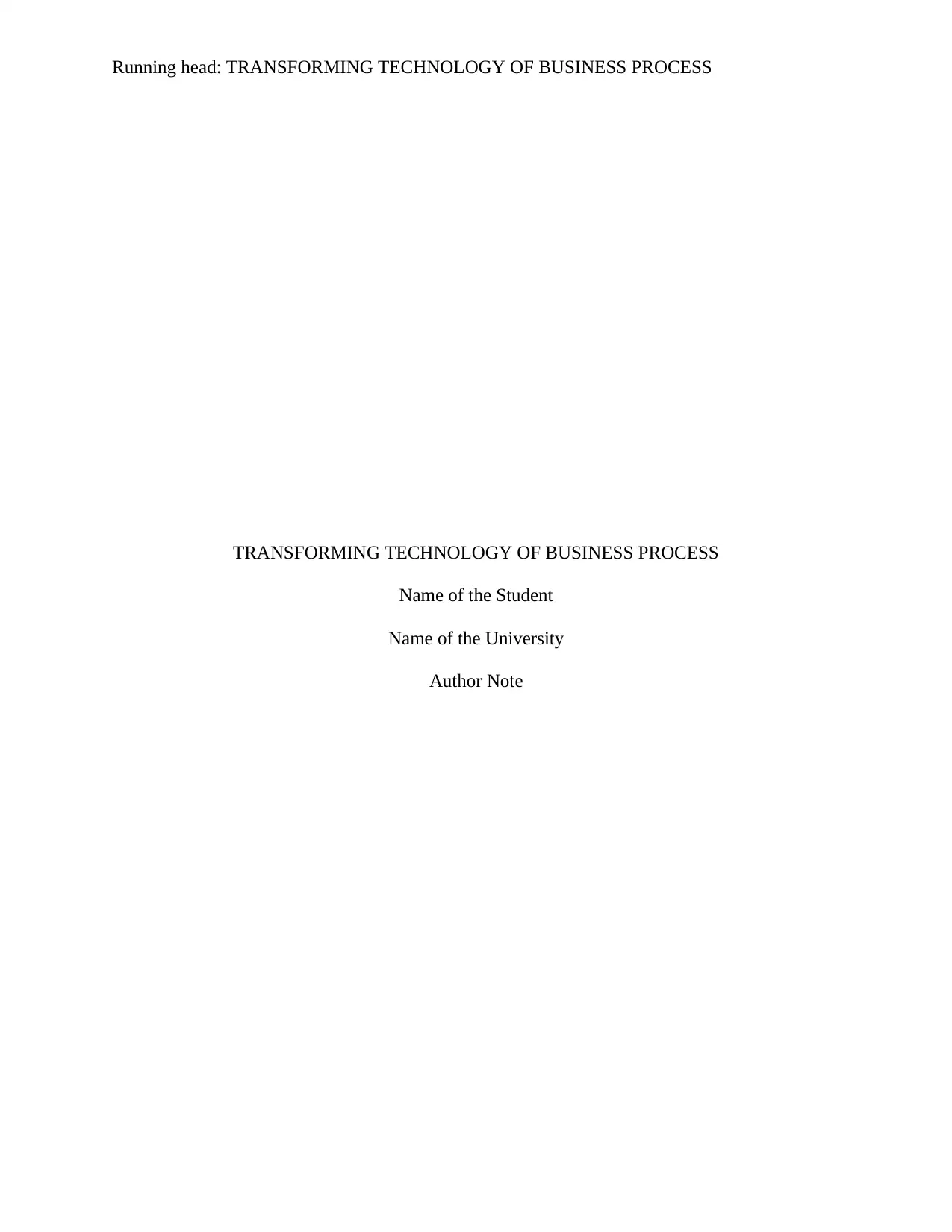
Running head: TRANSFORMING TECHNOLOGY OF BUSINESS PROCESS
TRANSFORMING TECHNOLOGY OF BUSINESS PROCESS
Name of the Student
Name of the University
Author Note
TRANSFORMING TECHNOLOGY OF BUSINESS PROCESS
Name of the Student
Name of the University
Author Note
Paraphrase This Document
Need a fresh take? Get an instant paraphrase of this document with our AI Paraphraser
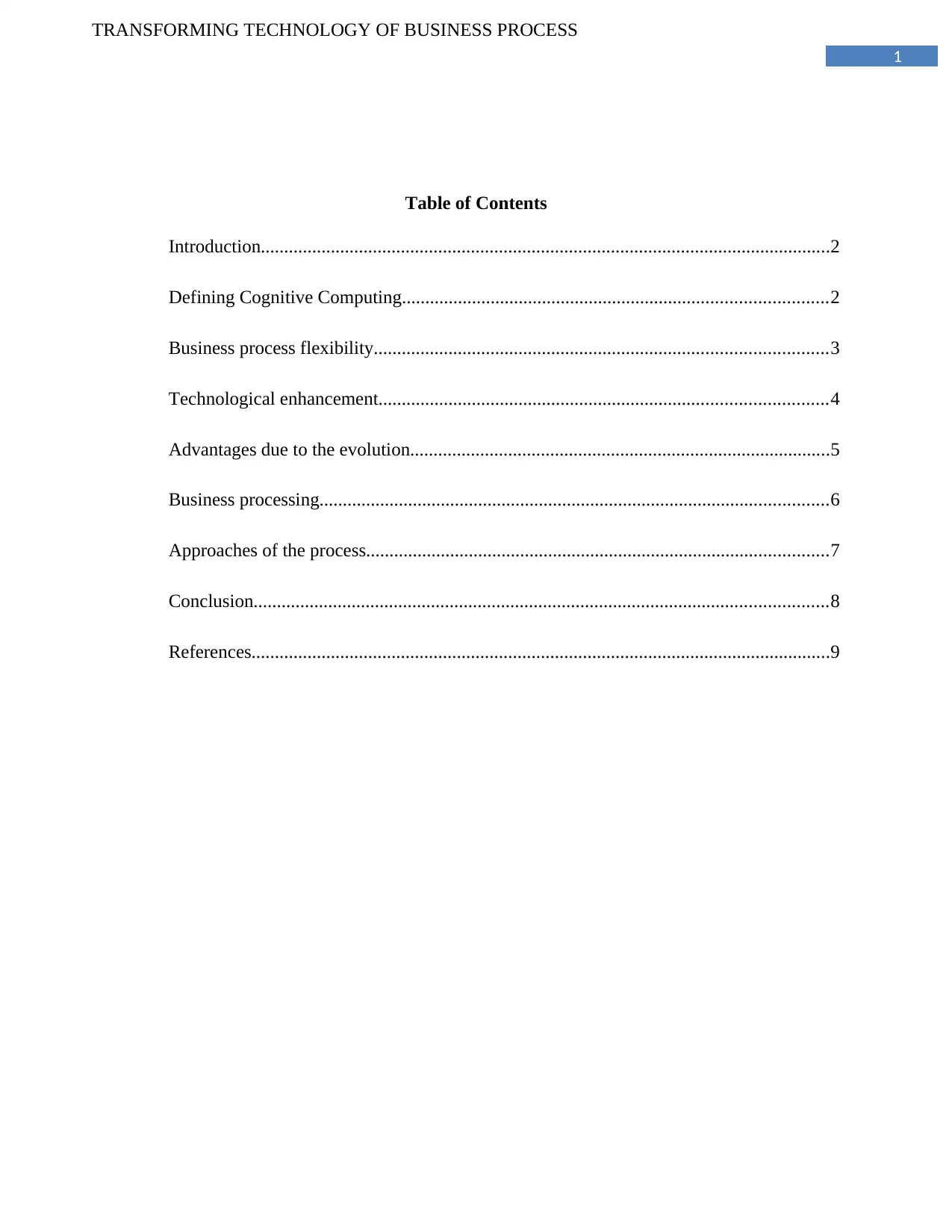
1
TRANSFORMING TECHNOLOGY OF BUSINESS PROCESS
Table of Contents
Introduction..........................................................................................................................2
Defining Cognitive Computing...........................................................................................2
Business process flexibility.................................................................................................3
Technological enhancement................................................................................................4
Advantages due to the evolution..........................................................................................5
Business processing.............................................................................................................6
Approaches of the process...................................................................................................7
Conclusion...........................................................................................................................8
References............................................................................................................................9
TRANSFORMING TECHNOLOGY OF BUSINESS PROCESS
Table of Contents
Introduction..........................................................................................................................2
Defining Cognitive Computing...........................................................................................2
Business process flexibility.................................................................................................3
Technological enhancement................................................................................................4
Advantages due to the evolution..........................................................................................5
Business processing.............................................................................................................6
Approaches of the process...................................................................................................7
Conclusion...........................................................................................................................8
References............................................................................................................................9
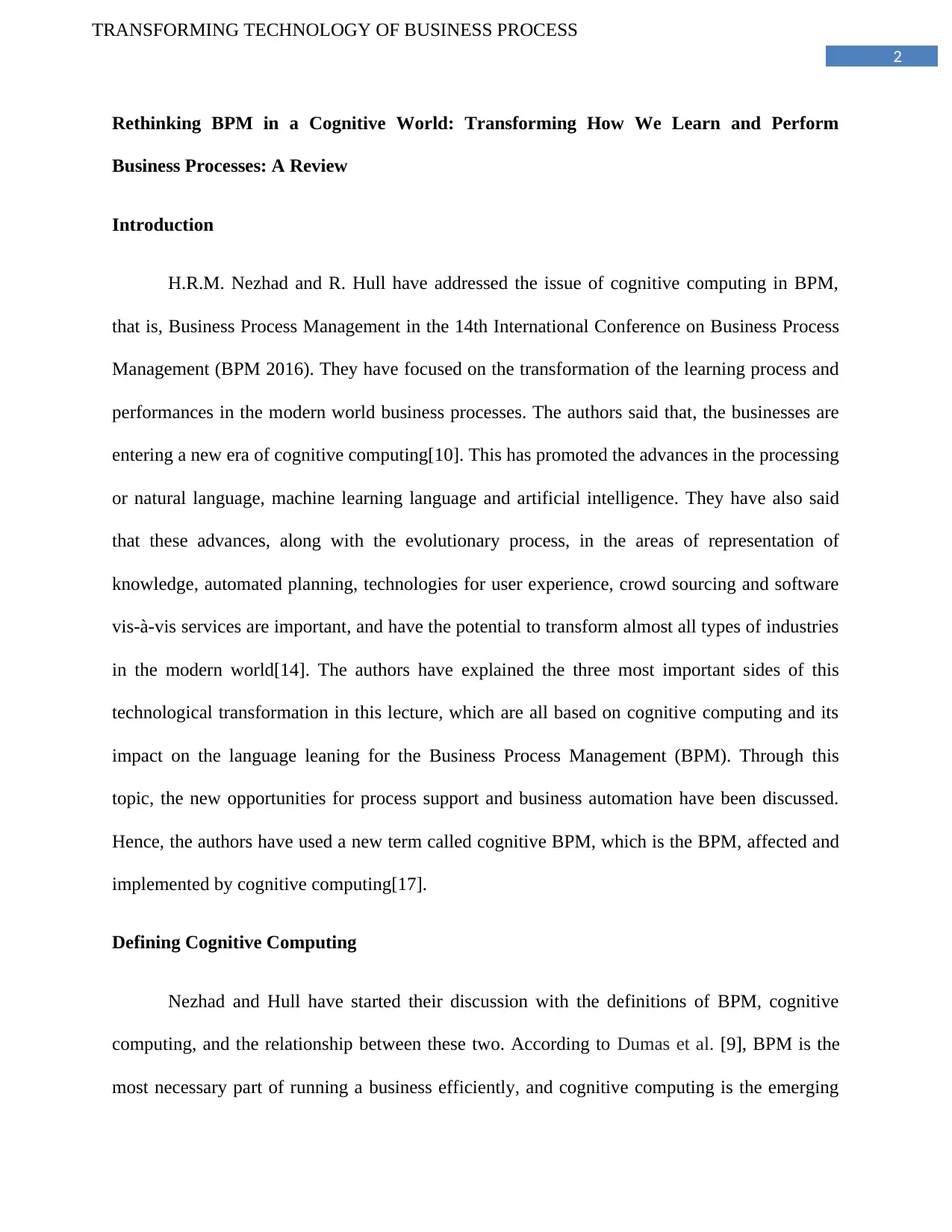
2
TRANSFORMING TECHNOLOGY OF BUSINESS PROCESS
Rethinking BPM in a Cognitive World: Transforming How We Learn and Perform
Business Processes: A Review
Introduction
H.R.M. Nezhad and R. Hull have addressed the issue of cognitive computing in BPM,
that is, Business Process Management in the 14th International Conference on Business Process
Management (BPM 2016). They have focused on the transformation of the learning process and
performances in the modern world business processes. The authors said that, the businesses are
entering a new era of cognitive computing[10]. This has promoted the advances in the processing
or natural language, machine learning language and artificial intelligence. They have also said
that these advances, along with the evolutionary process, in the areas of representation of
knowledge, automated planning, technologies for user experience, crowd sourcing and software
vis-à-vis services are important, and have the potential to transform almost all types of industries
in the modern world[14]. The authors have explained the three most important sides of this
technological transformation in this lecture, which are all based on cognitive computing and its
impact on the language leaning for the Business Process Management (BPM). Through this
topic, the new opportunities for process support and business automation have been discussed.
Hence, the authors have used a new term called cognitive BPM, which is the BPM, affected and
implemented by cognitive computing[17].
Defining Cognitive Computing
Nezhad and Hull have started their discussion with the definitions of BPM, cognitive
computing, and the relationship between these two. According to Dumas et al. [9], BPM is the
most necessary part of running a business efficiently, and cognitive computing is the emerging
TRANSFORMING TECHNOLOGY OF BUSINESS PROCESS
Rethinking BPM in a Cognitive World: Transforming How We Learn and Perform
Business Processes: A Review
Introduction
H.R.M. Nezhad and R. Hull have addressed the issue of cognitive computing in BPM,
that is, Business Process Management in the 14th International Conference on Business Process
Management (BPM 2016). They have focused on the transformation of the learning process and
performances in the modern world business processes. The authors said that, the businesses are
entering a new era of cognitive computing[10]. This has promoted the advances in the processing
or natural language, machine learning language and artificial intelligence. They have also said
that these advances, along with the evolutionary process, in the areas of representation of
knowledge, automated planning, technologies for user experience, crowd sourcing and software
vis-à-vis services are important, and have the potential to transform almost all types of industries
in the modern world[14]. The authors have explained the three most important sides of this
technological transformation in this lecture, which are all based on cognitive computing and its
impact on the language leaning for the Business Process Management (BPM). Through this
topic, the new opportunities for process support and business automation have been discussed.
Hence, the authors have used a new term called cognitive BPM, which is the BPM, affected and
implemented by cognitive computing[17].
Defining Cognitive Computing
Nezhad and Hull have started their discussion with the definitions of BPM, cognitive
computing, and the relationship between these two. According to Dumas et al. [9], BPM is the
most necessary part of running a business efficiently, and cognitive computing is the emerging
⊘ This is a preview!⊘
Do you want full access?
Subscribe today to unlock all pages.

Trusted by 1+ million students worldwide
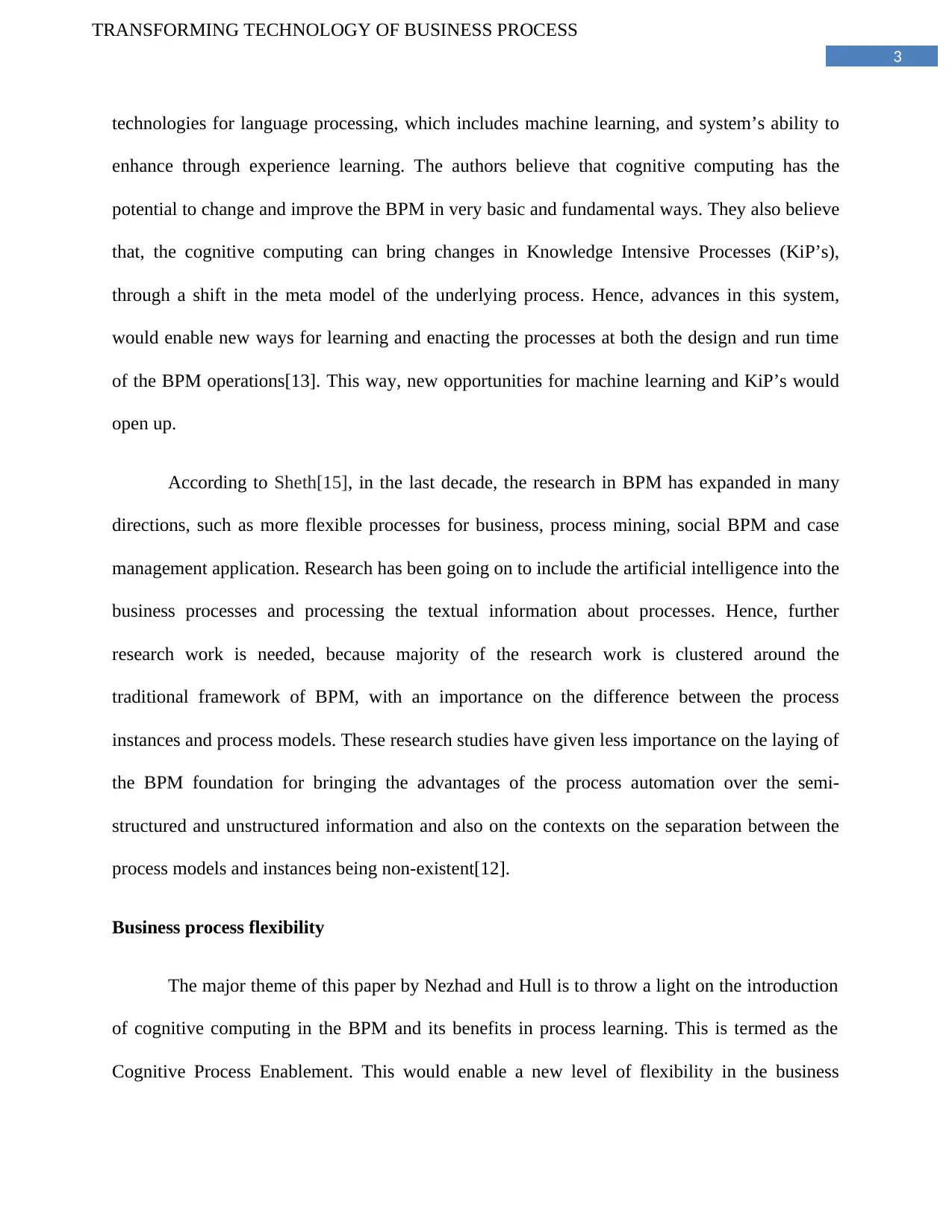
3
TRANSFORMING TECHNOLOGY OF BUSINESS PROCESS
technologies for language processing, which includes machine learning, and system’s ability to
enhance through experience learning. The authors believe that cognitive computing has the
potential to change and improve the BPM in very basic and fundamental ways. They also believe
that, the cognitive computing can bring changes in Knowledge Intensive Processes (KiP’s),
through a shift in the meta model of the underlying process. Hence, advances in this system,
would enable new ways for learning and enacting the processes at both the design and run time
of the BPM operations[13]. This way, new opportunities for machine learning and KiP’s would
open up.
According to Sheth[15], in the last decade, the research in BPM has expanded in many
directions, such as more flexible processes for business, process mining, social BPM and case
management application. Research has been going on to include the artificial intelligence into the
business processes and processing the textual information about processes. Hence, further
research work is needed, because majority of the research work is clustered around the
traditional framework of BPM, with an importance on the difference between the process
instances and process models. These research studies have given less importance on the laying of
the BPM foundation for bringing the advantages of the process automation over the semi-
structured and unstructured information and also on the contexts on the separation between the
process models and instances being non-existent[12].
Business process flexibility
The major theme of this paper by Nezhad and Hull is to throw a light on the introduction
of cognitive computing in the BPM and its benefits in process learning. This is termed as the
Cognitive Process Enablement. This would enable a new level of flexibility in the business
TRANSFORMING TECHNOLOGY OF BUSINESS PROCESS
technologies for language processing, which includes machine learning, and system’s ability to
enhance through experience learning. The authors believe that cognitive computing has the
potential to change and improve the BPM in very basic and fundamental ways. They also believe
that, the cognitive computing can bring changes in Knowledge Intensive Processes (KiP’s),
through a shift in the meta model of the underlying process. Hence, advances in this system,
would enable new ways for learning and enacting the processes at both the design and run time
of the BPM operations[13]. This way, new opportunities for machine learning and KiP’s would
open up.
According to Sheth[15], in the last decade, the research in BPM has expanded in many
directions, such as more flexible processes for business, process mining, social BPM and case
management application. Research has been going on to include the artificial intelligence into the
business processes and processing the textual information about processes. Hence, further
research work is needed, because majority of the research work is clustered around the
traditional framework of BPM, with an importance on the difference between the process
instances and process models. These research studies have given less importance on the laying of
the BPM foundation for bringing the advantages of the process automation over the semi-
structured and unstructured information and also on the contexts on the separation between the
process models and instances being non-existent[12].
Business process flexibility
The major theme of this paper by Nezhad and Hull is to throw a light on the introduction
of cognitive computing in the BPM and its benefits in process learning. This is termed as the
Cognitive Process Enablement. This would enable a new level of flexibility in the business
Paraphrase This Document
Need a fresh take? Get an instant paraphrase of this document with our AI Paraphraser
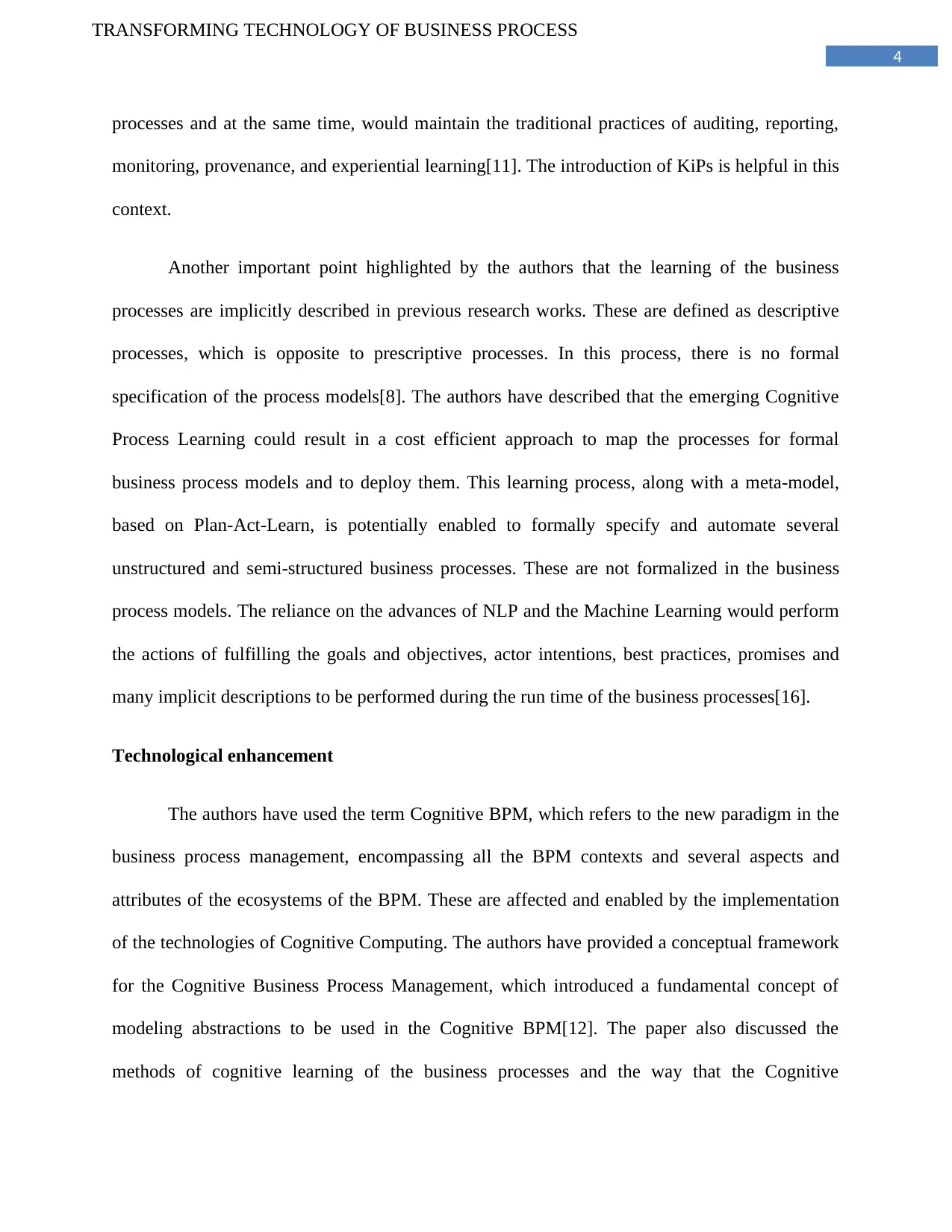
4
TRANSFORMING TECHNOLOGY OF BUSINESS PROCESS
processes and at the same time, would maintain the traditional practices of auditing, reporting,
monitoring, provenance, and experiential learning[11]. The introduction of KiPs is helpful in this
context.
Another important point highlighted by the authors that the learning of the business
processes are implicitly described in previous research works. These are defined as descriptive
processes, which is opposite to prescriptive processes. In this process, there is no formal
specification of the process models[8]. The authors have described that the emerging Cognitive
Process Learning could result in a cost efficient approach to map the processes for formal
business process models and to deploy them. This learning process, along with a meta-model,
based on Plan-Act-Learn, is potentially enabled to formally specify and automate several
unstructured and semi-structured business processes. These are not formalized in the business
process models. The reliance on the advances of NLP and the Machine Learning would perform
the actions of fulfilling the goals and objectives, actor intentions, best practices, promises and
many implicit descriptions to be performed during the run time of the business processes[16].
Technological enhancement
The authors have used the term Cognitive BPM, which refers to the new paradigm in the
business process management, encompassing all the BPM contexts and several aspects and
attributes of the ecosystems of the BPM. These are affected and enabled by the implementation
of the technologies of Cognitive Computing. The authors have provided a conceptual framework
for the Cognitive Business Process Management, which introduced a fundamental concept of
modeling abstractions to be used in the Cognitive BPM[12]. The paper also discussed the
methods of cognitive learning of the business processes and the way that the Cognitive
TRANSFORMING TECHNOLOGY OF BUSINESS PROCESS
processes and at the same time, would maintain the traditional practices of auditing, reporting,
monitoring, provenance, and experiential learning[11]. The introduction of KiPs is helpful in this
context.
Another important point highlighted by the authors that the learning of the business
processes are implicitly described in previous research works. These are defined as descriptive
processes, which is opposite to prescriptive processes. In this process, there is no formal
specification of the process models[8]. The authors have described that the emerging Cognitive
Process Learning could result in a cost efficient approach to map the processes for formal
business process models and to deploy them. This learning process, along with a meta-model,
based on Plan-Act-Learn, is potentially enabled to formally specify and automate several
unstructured and semi-structured business processes. These are not formalized in the business
process models. The reliance on the advances of NLP and the Machine Learning would perform
the actions of fulfilling the goals and objectives, actor intentions, best practices, promises and
many implicit descriptions to be performed during the run time of the business processes[16].
Technological enhancement
The authors have used the term Cognitive BPM, which refers to the new paradigm in the
business process management, encompassing all the BPM contexts and several aspects and
attributes of the ecosystems of the BPM. These are affected and enabled by the implementation
of the technologies of Cognitive Computing. The authors have provided a conceptual framework
for the Cognitive Business Process Management, which introduced a fundamental concept of
modeling abstractions to be used in the Cognitive BPM[12]. The paper also discussed the
methods of cognitive learning of the business processes and the way that the Cognitive
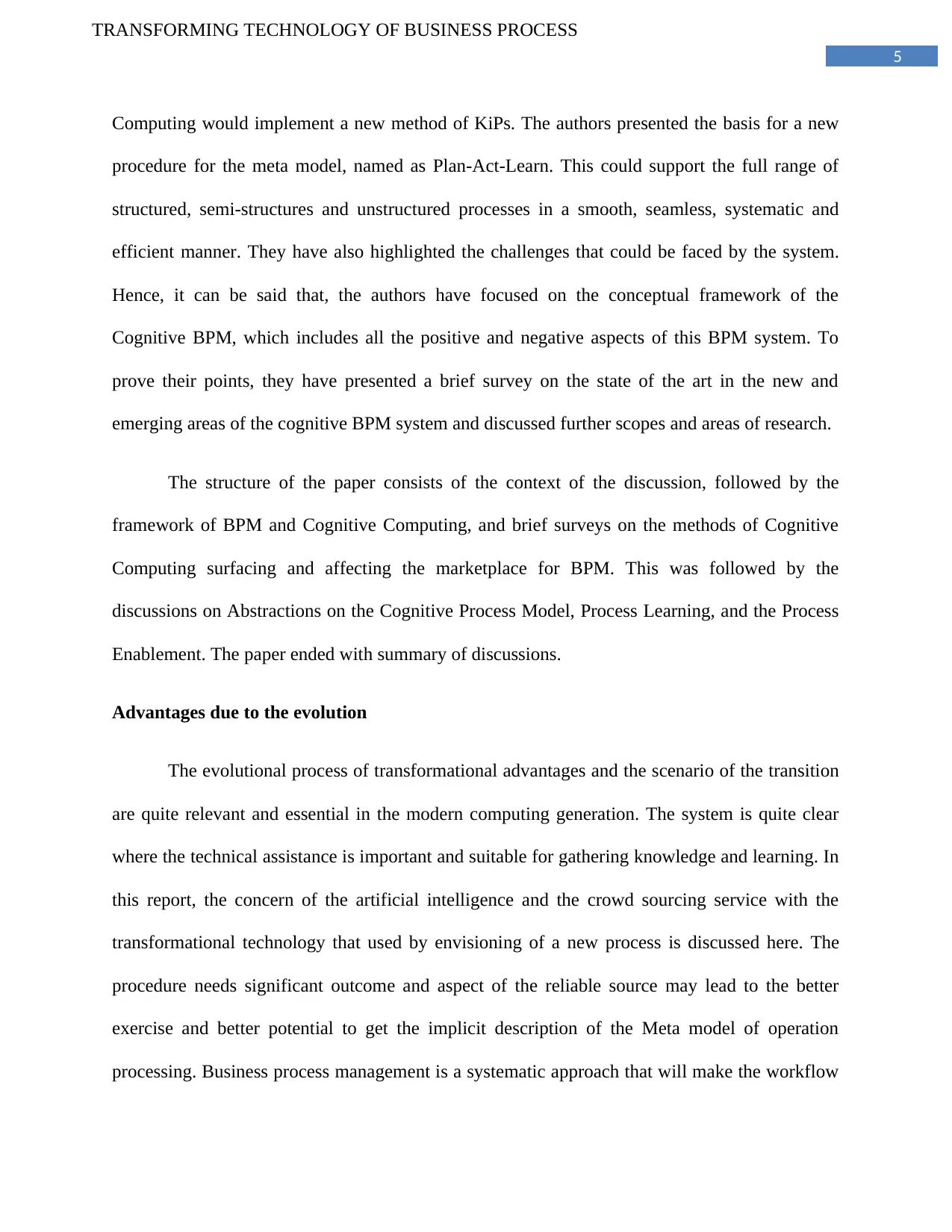
5
TRANSFORMING TECHNOLOGY OF BUSINESS PROCESS
Computing would implement a new method of KiPs. The authors presented the basis for a new
procedure for the meta model, named as Plan-Act-Learn. This could support the full range of
structured, semi-structures and unstructured processes in a smooth, seamless, systematic and
efficient manner. They have also highlighted the challenges that could be faced by the system.
Hence, it can be said that, the authors have focused on the conceptual framework of the
Cognitive BPM, which includes all the positive and negative aspects of this BPM system. To
prove their points, they have presented a brief survey on the state of the art in the new and
emerging areas of the cognitive BPM system and discussed further scopes and areas of research.
The structure of the paper consists of the context of the discussion, followed by the
framework of BPM and Cognitive Computing, and brief surveys on the methods of Cognitive
Computing surfacing and affecting the marketplace for BPM. This was followed by the
discussions on Abstractions on the Cognitive Process Model, Process Learning, and the Process
Enablement. The paper ended with summary of discussions.
Advantages due to the evolution
The evolutional process of transformational advantages and the scenario of the transition
are quite relevant and essential in the modern computing generation. The system is quite clear
where the technical assistance is important and suitable for gathering knowledge and learning. In
this report, the concern of the artificial intelligence and the crowd sourcing service with the
transformational technology that used by envisioning of a new process is discussed here. The
procedure needs significant outcome and aspect of the reliable source may lead to the better
exercise and better potential to get the implicit description of the Meta model of operation
processing. Business process management is a systematic approach that will make the workflow
TRANSFORMING TECHNOLOGY OF BUSINESS PROCESS
Computing would implement a new method of KiPs. The authors presented the basis for a new
procedure for the meta model, named as Plan-Act-Learn. This could support the full range of
structured, semi-structures and unstructured processes in a smooth, seamless, systematic and
efficient manner. They have also highlighted the challenges that could be faced by the system.
Hence, it can be said that, the authors have focused on the conceptual framework of the
Cognitive BPM, which includes all the positive and negative aspects of this BPM system. To
prove their points, they have presented a brief survey on the state of the art in the new and
emerging areas of the cognitive BPM system and discussed further scopes and areas of research.
The structure of the paper consists of the context of the discussion, followed by the
framework of BPM and Cognitive Computing, and brief surveys on the methods of Cognitive
Computing surfacing and affecting the marketplace for BPM. This was followed by the
discussions on Abstractions on the Cognitive Process Model, Process Learning, and the Process
Enablement. The paper ended with summary of discussions.
Advantages due to the evolution
The evolutional process of transformational advantages and the scenario of the transition
are quite relevant and essential in the modern computing generation. The system is quite clear
where the technical assistance is important and suitable for gathering knowledge and learning. In
this report, the concern of the artificial intelligence and the crowd sourcing service with the
transformational technology that used by envisioning of a new process is discussed here. The
procedure needs significant outcome and aspect of the reliable source may lead to the better
exercise and better potential to get the implicit description of the Meta model of operation
processing. Business process management is a systematic approach that will make the workflow
⊘ This is a preview!⊘
Do you want full access?
Subscribe today to unlock all pages.

Trusted by 1+ million students worldwide
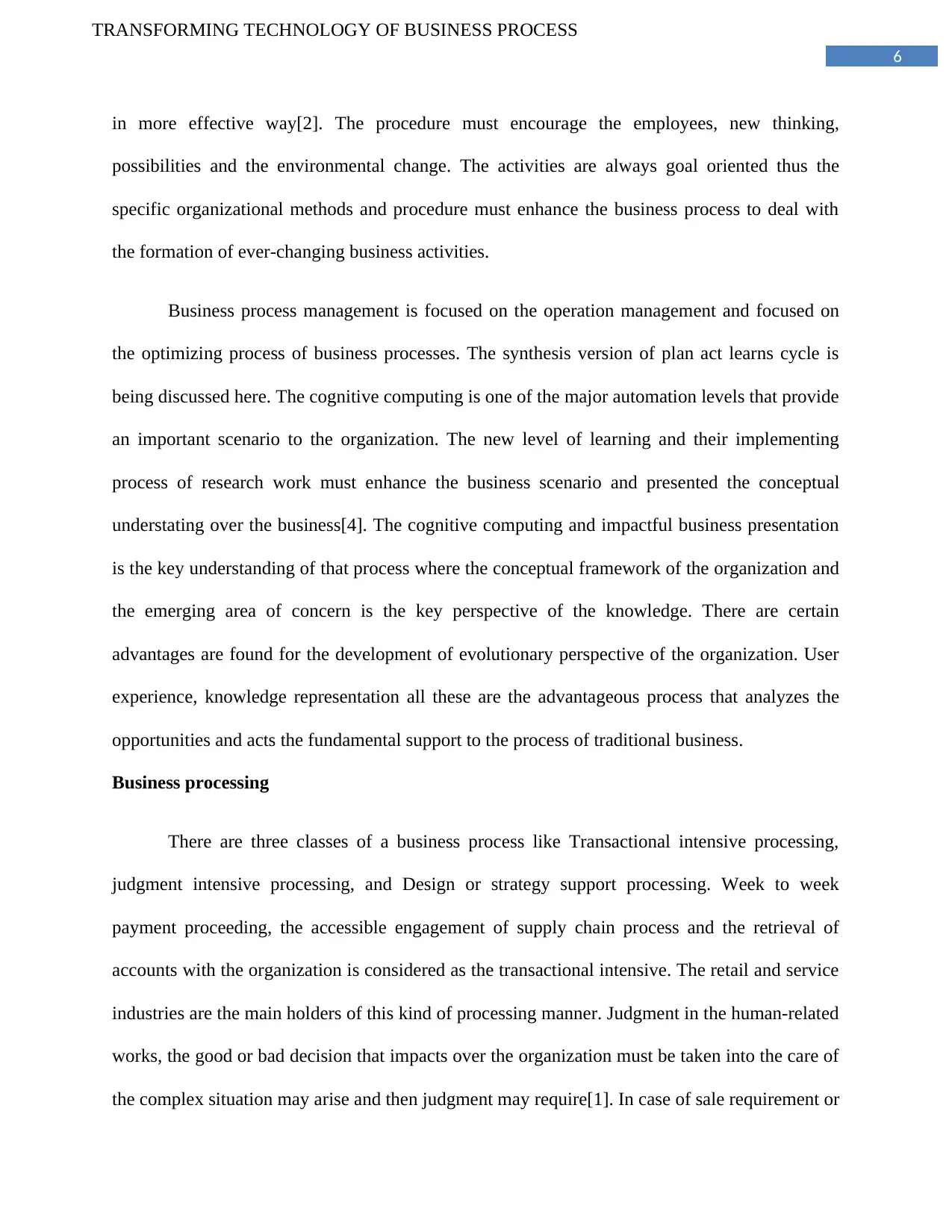
6
TRANSFORMING TECHNOLOGY OF BUSINESS PROCESS
in more effective way[2]. The procedure must encourage the employees, new thinking,
possibilities and the environmental change. The activities are always goal oriented thus the
specific organizational methods and procedure must enhance the business process to deal with
the formation of ever-changing business activities.
Business process management is focused on the operation management and focused on
the optimizing process of business processes. The synthesis version of plan act learns cycle is
being discussed here. The cognitive computing is one of the major automation levels that provide
an important scenario to the organization. The new level of learning and their implementing
process of research work must enhance the business scenario and presented the conceptual
understating over the business[4]. The cognitive computing and impactful business presentation
is the key understanding of that process where the conceptual framework of the organization and
the emerging area of concern is the key perspective of the knowledge. There are certain
advantages are found for the development of evolutionary perspective of the organization. User
experience, knowledge representation all these are the advantageous process that analyzes the
opportunities and acts the fundamental support to the process of traditional business.
Business processing
There are three classes of a business process like Transactional intensive processing,
judgment intensive processing, and Design or strategy support processing. Week to week
payment proceeding, the accessible engagement of supply chain process and the retrieval of
accounts with the organization is considered as the transactional intensive. The retail and service
industries are the main holders of this kind of processing manner. Judgment in the human-related
works, the good or bad decision that impacts over the organization must be taken into the care of
the complex situation may arise and then judgment may require[1]. In case of sale requirement or
TRANSFORMING TECHNOLOGY OF BUSINESS PROCESS
in more effective way[2]. The procedure must encourage the employees, new thinking,
possibilities and the environmental change. The activities are always goal oriented thus the
specific organizational methods and procedure must enhance the business process to deal with
the formation of ever-changing business activities.
Business process management is focused on the operation management and focused on
the optimizing process of business processes. The synthesis version of plan act learns cycle is
being discussed here. The cognitive computing is one of the major automation levels that provide
an important scenario to the organization. The new level of learning and their implementing
process of research work must enhance the business scenario and presented the conceptual
understating over the business[4]. The cognitive computing and impactful business presentation
is the key understanding of that process where the conceptual framework of the organization and
the emerging area of concern is the key perspective of the knowledge. There are certain
advantages are found for the development of evolutionary perspective of the organization. User
experience, knowledge representation all these are the advantageous process that analyzes the
opportunities and acts the fundamental support to the process of traditional business.
Business processing
There are three classes of a business process like Transactional intensive processing,
judgment intensive processing, and Design or strategy support processing. Week to week
payment proceeding, the accessible engagement of supply chain process and the retrieval of
accounts with the organization is considered as the transactional intensive. The retail and service
industries are the main holders of this kind of processing manner. Judgment in the human-related
works, the good or bad decision that impacts over the organization must be taken into the care of
the complex situation may arise and then judgment may require[1]. In case of sale requirement or
Paraphrase This Document
Need a fresh take? Get an instant paraphrase of this document with our AI Paraphraser
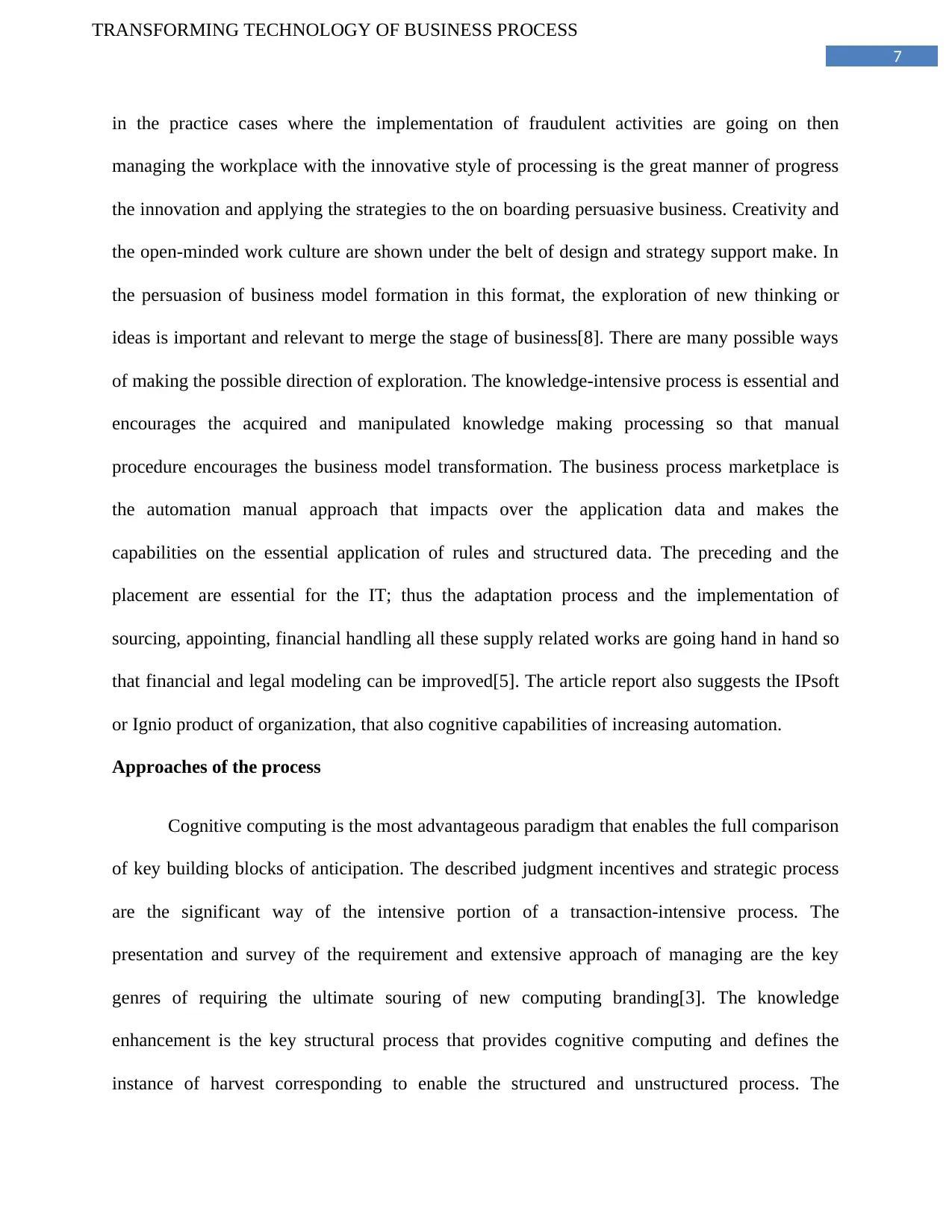
7
TRANSFORMING TECHNOLOGY OF BUSINESS PROCESS
in the practice cases where the implementation of fraudulent activities are going on then
managing the workplace with the innovative style of processing is the great manner of progress
the innovation and applying the strategies to the on boarding persuasive business. Creativity and
the open-minded work culture are shown under the belt of design and strategy support make. In
the persuasion of business model formation in this format, the exploration of new thinking or
ideas is important and relevant to merge the stage of business[8]. There are many possible ways
of making the possible direction of exploration. The knowledge-intensive process is essential and
encourages the acquired and manipulated knowledge making processing so that manual
procedure encourages the business model transformation. The business process marketplace is
the automation manual approach that impacts over the application data and makes the
capabilities on the essential application of rules and structured data. The preceding and the
placement are essential for the IT; thus the adaptation process and the implementation of
sourcing, appointing, financial handling all these supply related works are going hand in hand so
that financial and legal modeling can be improved[5]. The article report also suggests the IPsoft
or Ignio product of organization, that also cognitive capabilities of increasing automation.
Approaches of the process
Cognitive computing is the most advantageous paradigm that enables the full comparison
of key building blocks of anticipation. The described judgment incentives and strategic process
are the significant way of the intensive portion of a transaction-intensive process. The
presentation and survey of the requirement and extensive approach of managing are the key
genres of requiring the ultimate souring of new computing branding[3]. The knowledge
enhancement is the key structural process that provides cognitive computing and defines the
instance of harvest corresponding to enable the structured and unstructured process. The
TRANSFORMING TECHNOLOGY OF BUSINESS PROCESS
in the practice cases where the implementation of fraudulent activities are going on then
managing the workplace with the innovative style of processing is the great manner of progress
the innovation and applying the strategies to the on boarding persuasive business. Creativity and
the open-minded work culture are shown under the belt of design and strategy support make. In
the persuasion of business model formation in this format, the exploration of new thinking or
ideas is important and relevant to merge the stage of business[8]. There are many possible ways
of making the possible direction of exploration. The knowledge-intensive process is essential and
encourages the acquired and manipulated knowledge making processing so that manual
procedure encourages the business model transformation. The business process marketplace is
the automation manual approach that impacts over the application data and makes the
capabilities on the essential application of rules and structured data. The preceding and the
placement are essential for the IT; thus the adaptation process and the implementation of
sourcing, appointing, financial handling all these supply related works are going hand in hand so
that financial and legal modeling can be improved[5]. The article report also suggests the IPsoft
or Ignio product of organization, that also cognitive capabilities of increasing automation.
Approaches of the process
Cognitive computing is the most advantageous paradigm that enables the full comparison
of key building blocks of anticipation. The described judgment incentives and strategic process
are the significant way of the intensive portion of a transaction-intensive process. The
presentation and survey of the requirement and extensive approach of managing are the key
genres of requiring the ultimate souring of new computing branding[3]. The knowledge
enhancement is the key structural process that provides cognitive computing and defines the
instance of harvest corresponding to enable the structured and unstructured process. The
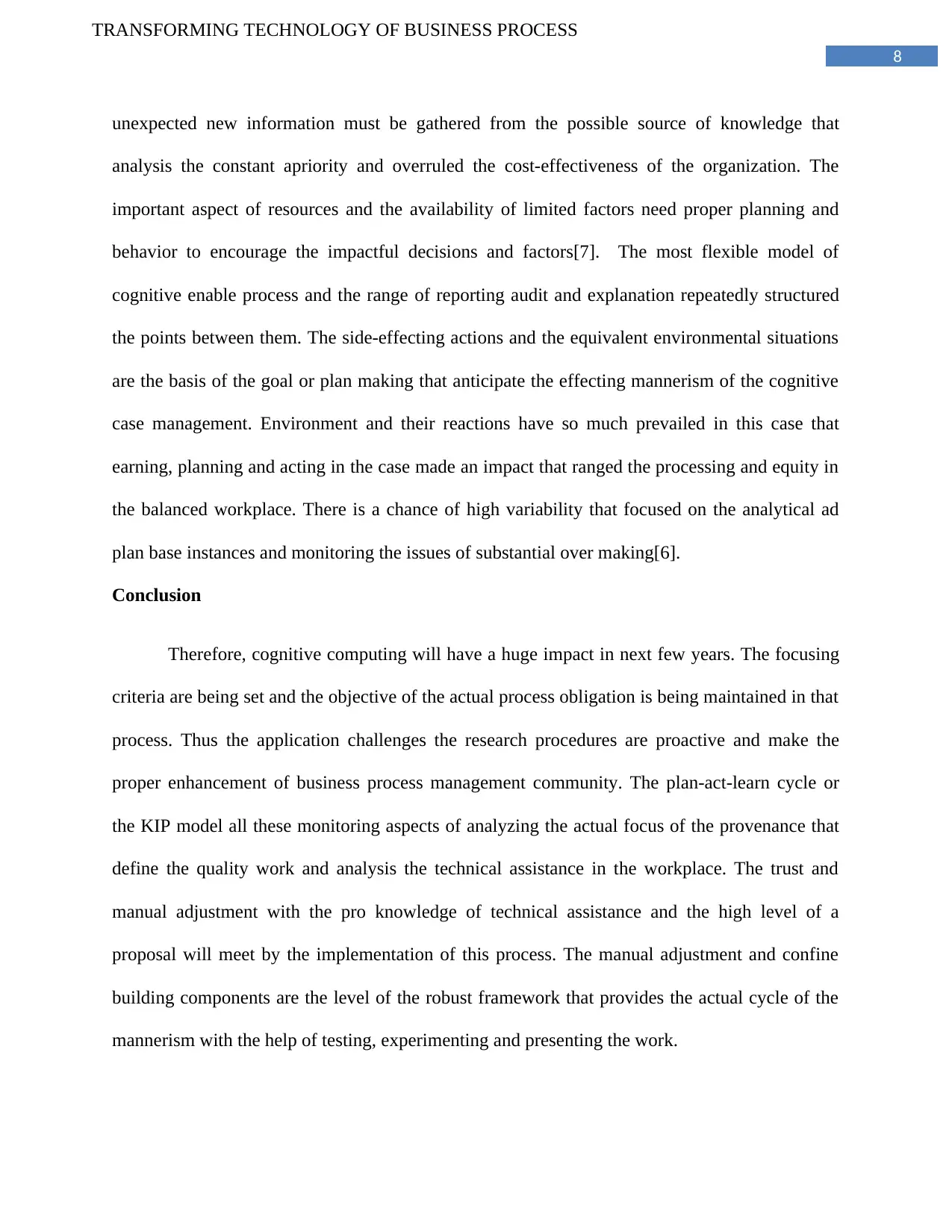
8
TRANSFORMING TECHNOLOGY OF BUSINESS PROCESS
unexpected new information must be gathered from the possible source of knowledge that
analysis the constant apriority and overruled the cost-effectiveness of the organization. The
important aspect of resources and the availability of limited factors need proper planning and
behavior to encourage the impactful decisions and factors[7]. The most flexible model of
cognitive enable process and the range of reporting audit and explanation repeatedly structured
the points between them. The side-effecting actions and the equivalent environmental situations
are the basis of the goal or plan making that anticipate the effecting mannerism of the cognitive
case management. Environment and their reactions have so much prevailed in this case that
earning, planning and acting in the case made an impact that ranged the processing and equity in
the balanced workplace. There is a chance of high variability that focused on the analytical ad
plan base instances and monitoring the issues of substantial over making[6].
Conclusion
Therefore, cognitive computing will have a huge impact in next few years. The focusing
criteria are being set and the objective of the actual process obligation is being maintained in that
process. Thus the application challenges the research procedures are proactive and make the
proper enhancement of business process management community. The plan-act-learn cycle or
the KIP model all these monitoring aspects of analyzing the actual focus of the provenance that
define the quality work and analysis the technical assistance in the workplace. The trust and
manual adjustment with the pro knowledge of technical assistance and the high level of a
proposal will meet by the implementation of this process. The manual adjustment and confine
building components are the level of the robust framework that provides the actual cycle of the
mannerism with the help of testing, experimenting and presenting the work.
TRANSFORMING TECHNOLOGY OF BUSINESS PROCESS
unexpected new information must be gathered from the possible source of knowledge that
analysis the constant apriority and overruled the cost-effectiveness of the organization. The
important aspect of resources and the availability of limited factors need proper planning and
behavior to encourage the impactful decisions and factors[7]. The most flexible model of
cognitive enable process and the range of reporting audit and explanation repeatedly structured
the points between them. The side-effecting actions and the equivalent environmental situations
are the basis of the goal or plan making that anticipate the effecting mannerism of the cognitive
case management. Environment and their reactions have so much prevailed in this case that
earning, planning and acting in the case made an impact that ranged the processing and equity in
the balanced workplace. There is a chance of high variability that focused on the analytical ad
plan base instances and monitoring the issues of substantial over making[6].
Conclusion
Therefore, cognitive computing will have a huge impact in next few years. The focusing
criteria are being set and the objective of the actual process obligation is being maintained in that
process. Thus the application challenges the research procedures are proactive and make the
proper enhancement of business process management community. The plan-act-learn cycle or
the KIP model all these monitoring aspects of analyzing the actual focus of the provenance that
define the quality work and analysis the technical assistance in the workplace. The trust and
manual adjustment with the pro knowledge of technical assistance and the high level of a
proposal will meet by the implementation of this process. The manual adjustment and confine
building components are the level of the robust framework that provides the actual cycle of the
mannerism with the help of testing, experimenting and presenting the work.
⊘ This is a preview!⊘
Do you want full access?
Subscribe today to unlock all pages.

Trusted by 1+ million students worldwide
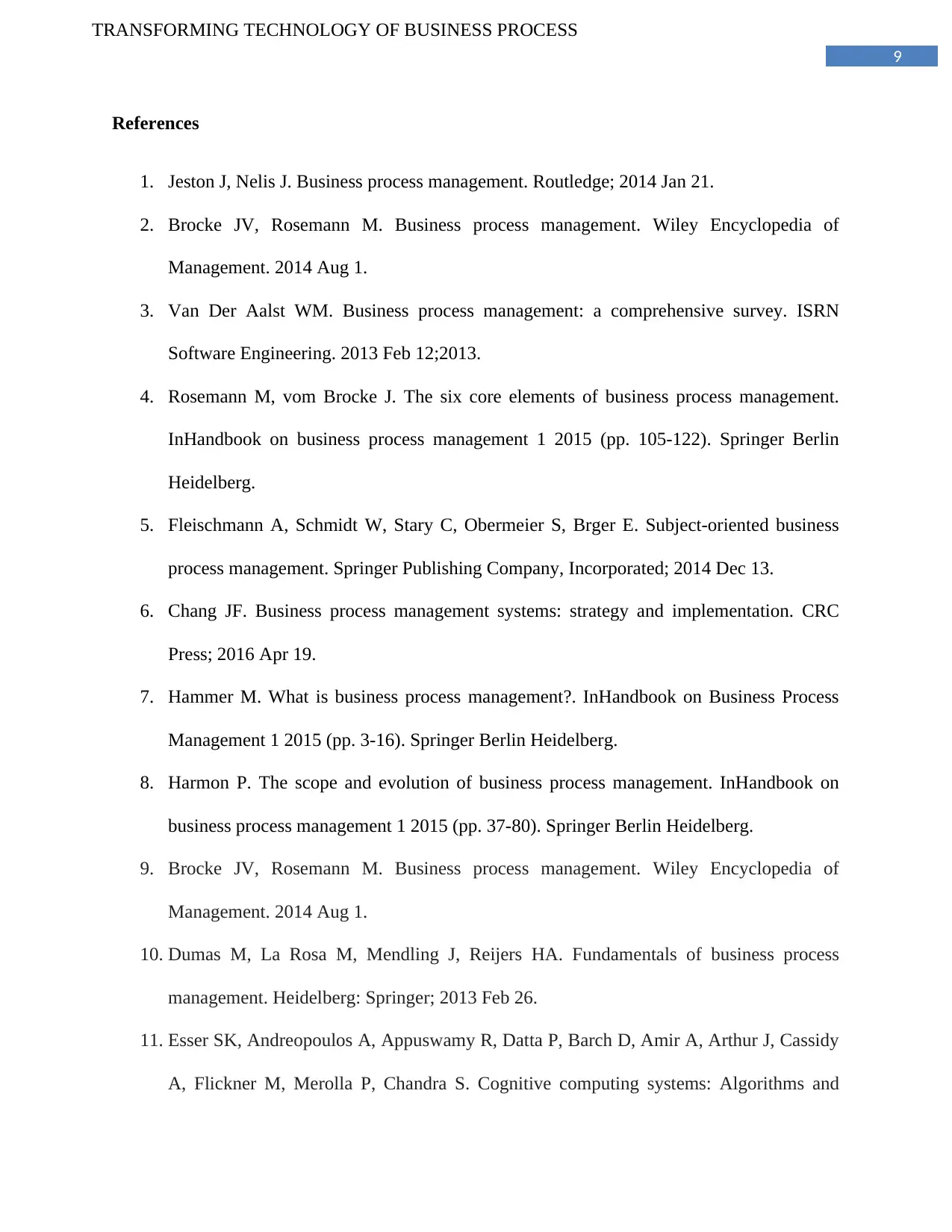
9
TRANSFORMING TECHNOLOGY OF BUSINESS PROCESS
References
1. Jeston J, Nelis J. Business process management. Routledge; 2014 Jan 21.
2. Brocke JV, Rosemann M. Business process management. Wiley Encyclopedia of
Management. 2014 Aug 1.
3. Van Der Aalst WM. Business process management: a comprehensive survey. ISRN
Software Engineering. 2013 Feb 12;2013.
4. Rosemann M, vom Brocke J. The six core elements of business process management.
InHandbook on business process management 1 2015 (pp. 105-122). Springer Berlin
Heidelberg.
5. Fleischmann A, Schmidt W, Stary C, Obermeier S, Brger E. Subject-oriented business
process management. Springer Publishing Company, Incorporated; 2014 Dec 13.
6. Chang JF. Business process management systems: strategy and implementation. CRC
Press; 2016 Apr 19.
7. Hammer M. What is business process management?. InHandbook on Business Process
Management 1 2015 (pp. 3-16). Springer Berlin Heidelberg.
8. Harmon P. The scope and evolution of business process management. InHandbook on
business process management 1 2015 (pp. 37-80). Springer Berlin Heidelberg.
9. Brocke JV, Rosemann M. Business process management. Wiley Encyclopedia of
Management. 2014 Aug 1.
10. Dumas M, La Rosa M, Mendling J, Reijers HA. Fundamentals of business process
management. Heidelberg: Springer; 2013 Feb 26.
11. Esser SK, Andreopoulos A, Appuswamy R, Datta P, Barch D, Amir A, Arthur J, Cassidy
A, Flickner M, Merolla P, Chandra S. Cognitive computing systems: Algorithms and
TRANSFORMING TECHNOLOGY OF BUSINESS PROCESS
References
1. Jeston J, Nelis J. Business process management. Routledge; 2014 Jan 21.
2. Brocke JV, Rosemann M. Business process management. Wiley Encyclopedia of
Management. 2014 Aug 1.
3. Van Der Aalst WM. Business process management: a comprehensive survey. ISRN
Software Engineering. 2013 Feb 12;2013.
4. Rosemann M, vom Brocke J. The six core elements of business process management.
InHandbook on business process management 1 2015 (pp. 105-122). Springer Berlin
Heidelberg.
5. Fleischmann A, Schmidt W, Stary C, Obermeier S, Brger E. Subject-oriented business
process management. Springer Publishing Company, Incorporated; 2014 Dec 13.
6. Chang JF. Business process management systems: strategy and implementation. CRC
Press; 2016 Apr 19.
7. Hammer M. What is business process management?. InHandbook on Business Process
Management 1 2015 (pp. 3-16). Springer Berlin Heidelberg.
8. Harmon P. The scope and evolution of business process management. InHandbook on
business process management 1 2015 (pp. 37-80). Springer Berlin Heidelberg.
9. Brocke JV, Rosemann M. Business process management. Wiley Encyclopedia of
Management. 2014 Aug 1.
10. Dumas M, La Rosa M, Mendling J, Reijers HA. Fundamentals of business process
management. Heidelberg: Springer; 2013 Feb 26.
11. Esser SK, Andreopoulos A, Appuswamy R, Datta P, Barch D, Amir A, Arthur J, Cassidy
A, Flickner M, Merolla P, Chandra S. Cognitive computing systems: Algorithms and
Paraphrase This Document
Need a fresh take? Get an instant paraphrase of this document with our AI Paraphraser
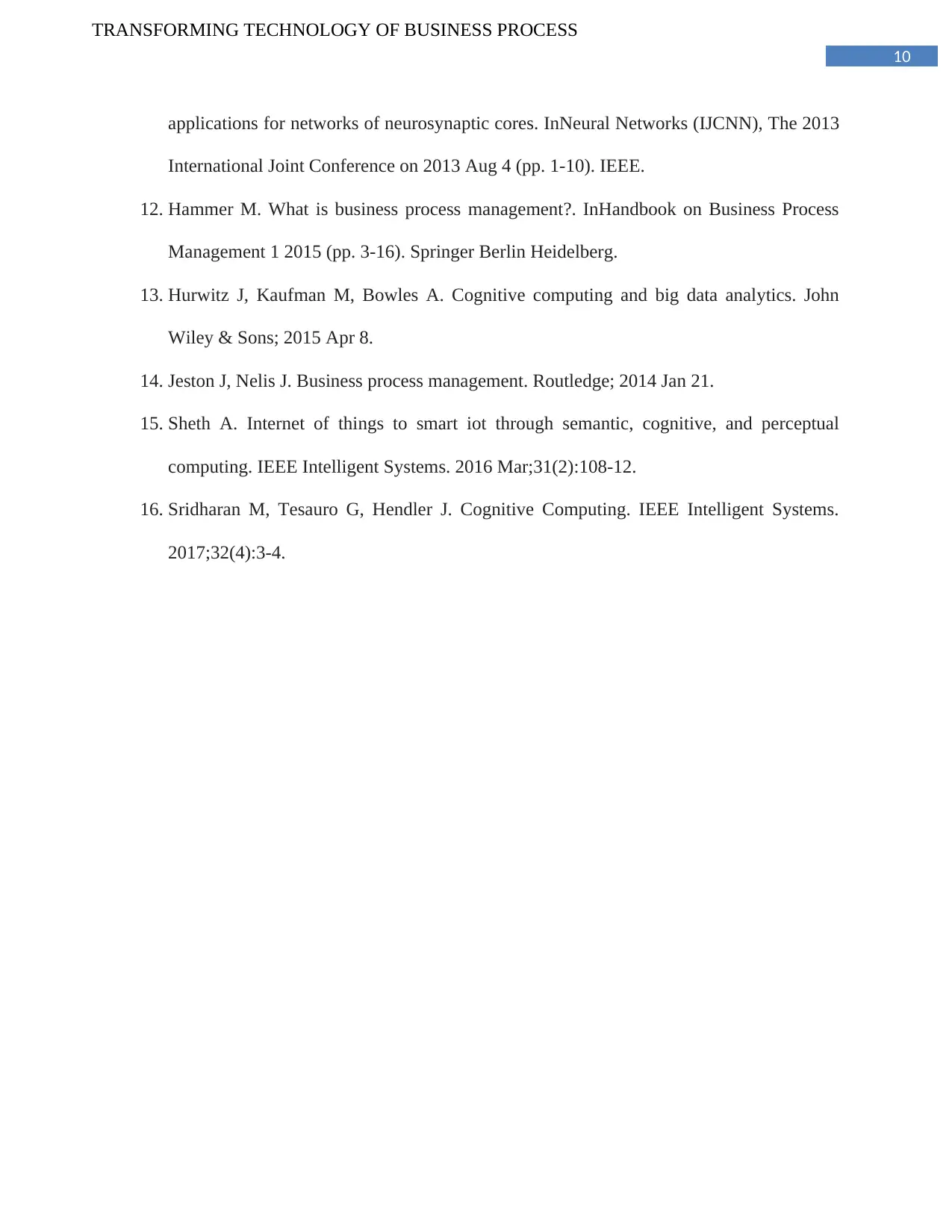
10
TRANSFORMING TECHNOLOGY OF BUSINESS PROCESS
applications for networks of neurosynaptic cores. InNeural Networks (IJCNN), The 2013
International Joint Conference on 2013 Aug 4 (pp. 1-10). IEEE.
12. Hammer M. What is business process management?. InHandbook on Business Process
Management 1 2015 (pp. 3-16). Springer Berlin Heidelberg.
13. Hurwitz J, Kaufman M, Bowles A. Cognitive computing and big data analytics. John
Wiley & Sons; 2015 Apr 8.
14. Jeston J, Nelis J. Business process management. Routledge; 2014 Jan 21.
15. Sheth A. Internet of things to smart iot through semantic, cognitive, and perceptual
computing. IEEE Intelligent Systems. 2016 Mar;31(2):108-12.
16. Sridharan M, Tesauro G, Hendler J. Cognitive Computing. IEEE Intelligent Systems.
2017;32(4):3-4.
TRANSFORMING TECHNOLOGY OF BUSINESS PROCESS
applications for networks of neurosynaptic cores. InNeural Networks (IJCNN), The 2013
International Joint Conference on 2013 Aug 4 (pp. 1-10). IEEE.
12. Hammer M. What is business process management?. InHandbook on Business Process
Management 1 2015 (pp. 3-16). Springer Berlin Heidelberg.
13. Hurwitz J, Kaufman M, Bowles A. Cognitive computing and big data analytics. John
Wiley & Sons; 2015 Apr 8.
14. Jeston J, Nelis J. Business process management. Routledge; 2014 Jan 21.
15. Sheth A. Internet of things to smart iot through semantic, cognitive, and perceptual
computing. IEEE Intelligent Systems. 2016 Mar;31(2):108-12.
16. Sridharan M, Tesauro G, Hendler J. Cognitive Computing. IEEE Intelligent Systems.
2017;32(4):3-4.
1 out of 11
Related Documents
Your All-in-One AI-Powered Toolkit for Academic Success.
+13062052269
info@desklib.com
Available 24*7 on WhatsApp / Email
![[object Object]](/_next/static/media/star-bottom.7253800d.svg)
Unlock your academic potential
Copyright © 2020–2025 A2Z Services. All Rights Reserved. Developed and managed by ZUCOL.





